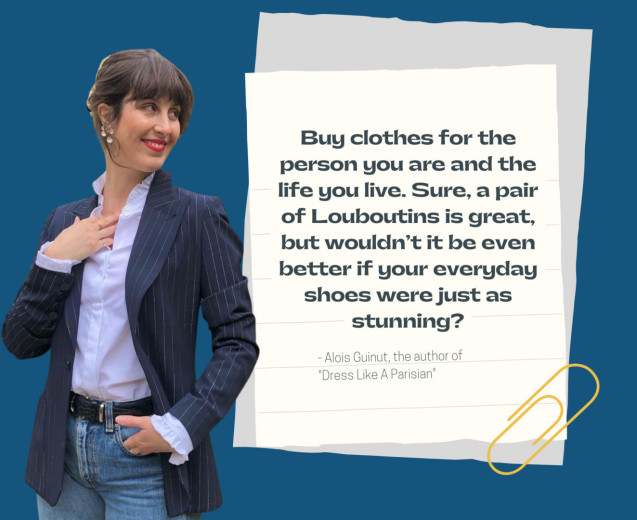Table of Contents
Parisian style is the pinnacle of elevated yet chic luxury. The Parisienne is not your average Jane. You will never find blingy jeans, fake designer bags or flimsy tops in her closet. She never chases trends but still exudes luxury and class – so, what is her secret?
According to the book, “Dress like A Parisian”, the Parisienne is the epitome of slow fashion. The magic recipe for her closet is buying a few but well-chosen clothes.
The Parisienne cultivates her closet the same way she grows plants on her balcony – with love. She has an eye for classic styles that last for generations to come. So, cheap dresses from Shein, UGG boots, and sweatpants are a big no-no in her book.
Truth be told, the Parisienne doesn’t like wasting money on clothes. On Sundays, you will catch her thrifting at the local flea market like a true bargain-hunter. After all, she cares about vintage more than fleeting trends. Like the true icon of French style, Yves Saint Laurent says, “fashion fades, style is eternal.”
What about brand names? Forget about them. French people take pride in NOT being influenced by logomania. They dress to please themselves, not to chase trends. Yet, if a fun trend comes back, they might call maman to see if she’s kept a pair of flare jeans from her high school years…
While not everyone can be Parisian, we all can follow French women’s footsteps. With a few high-quality, staple pieces, you can put together outfits that make you look like a walking billboard even on your worst day.
Forget the thrill of the buy for a moment. An expert curator of eco-friendly and stylish wardrobes, Alois Guinut shares with us her secrets of the Paris chic. In her book, “Dress Like A Parisian”, she explains how to pick the right clothes and combine them in creative ways just like French women do.
Working as a personal stylist, Guinut graduated from the French Institute of Fashion in Paris. She later started building a fashion-conscious community on Instagram, launching a personal blog Dress Like A Parisian.
In the book, Guinut urges us to buy less, dress better, and choose wisely in between. In other words, make the most out of the clothes you already own! Get ready to lay your entire closet bare, however. In the first chapter, Guinut advises us to take on a massive decluttering exercise – take a look at your belongings, estimate what you wear, and get rid of unwanted items.
Sounds exhausting, I know… But imagine how it feels to wake up to the wardrobe of your dreams! You’d be armed with creative ideas about how to combine your clothes with no decision fatigue. All while making the earth a better place.
What are some of your ‘lazy girl’ style tips for an eco-friendly wardrobe?
Ready for my French answer? Simply build a foundation of timeless basics (the ones that suit you, in versatile colors, in your style) and then spice them up with some accessories and statement pieces.
How effective is social media in bringing awareness on ethical fashion and making an impact?
My community is passionate about topics like sustainable fashion and labor rights, and I try my best to raise awareness about overconsumption in my Instagram stories. Many people tend to think, “oh, it’s okay if I make mistakes – I will just donate this garment to make others happy”, when their unused clothes end up polluting beaches in Botswana and in fact, make the locals very sad.
Would you say that dressing sustainably is more expensive?
Not necessarily because dressing sustainably is not only about ‘buying better’ but also ‘buying less.’ Ideally, it would reconcile both ‘buying less’ and ‘buying better’ principles. But if a person only fulfills the buying less part and shops at fast fashion brands, it’s much better than overconsuming sustainably labeled clothes. Although, generally, I recommend avoiding fast fashion altogether.
How do you convince your clients to ditch fast fashion for ‘must-haves’ and sustainable basics?
I try to adapt to my client’s personal style and improve it. The take-away from French style, which I implement as a stylist, is staying from ultra fast fashion pieces that will be outdated the next minute. But my clients and I are always open to styling fun pieces! along with the basics that work for them, of course. Not anyone needs a trench coat, you know.
What would be your style advice for college-aged young women who plan to transition into corporate careers? how should they build a smart closet to look both casual and presentable in their everyday life?
Well, I mostly work with French people and here, outfits for college and corporate life are not very different. But I know that in the US, college student dress kind of, uhmm, sloppy? So, I would just help them transition into their own adult style.
Lastly, what can shoppers do to make the planet a better place?
To all shoppers: buy less. You do not need the next big thing. Learn what suits you and dress better, wear and enjoy what you have by styling it creatively.
On your blog, you talked about the concept of Tsundoku, which means ‘piling up.’ Why do women end up piling up clothes they’ll never wear?
Fashion styling helps with avoiding Tsundoku, as it teaches them how to mix and match pieces in creative ways. As a stylist, I help clients identify what clothes they really need for assembling outfits and what items they’ll never end up wearing.
Editor’s Note: The opinions expressed here by Impakter.com columnists are their own, not those of Impakter.com. — Featured Photo Source: Shutterstock
 fashion rec fashion wanted
fashion rec fashion wanted



